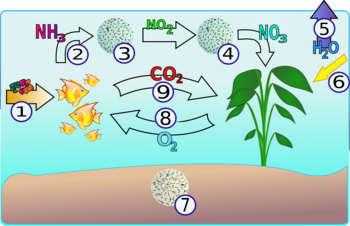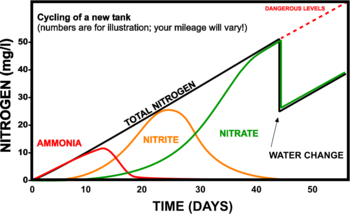The Nitrogen Cycle
Contents
What is the Nitrogen Cycle?
The nitrogen cycle describes the process whereby ammonia products, which are secreted by animals as waste, are converted by bacteria to nitrite and then into nitrate.
Ammonia and nitrite are highly toxic to fish in very low concentrations, so establishing the bacteria colonies that quickly convert these compounds to nitrate is crucial to creating a healthy environment for fish. Nitrate are far less toxic, and can easily be removed through periodic water changes or consumption by live plants. Most fish mortality in new tanks can be traced to the lack of an established nitrogen cycle in the tank.
Fish excrete urea, which contains ammonia. In a new tank that does not have the necessary bacteria colonies, this ammonia will rapidly accumulate to the point where it is toxic to the fish. Depending on the size of the tank and the number of fish, the ammonia may become toxic within one day to a week or so.
New Tank Syndrome (NTS) describes a tank that does not have the necessary bacteria colonies, and which kills fish as a result.
Every new tank must under o what is known as Cycling. During this time you must closely watch your tank and monitor the levels of ammonia, nitrite, and nitrate. By monitoring these parameters you will be able to tell when your tank has become habitable for fish, or if it is still in the Cycling phase.
Steps of the cycle
Ammonia
The cycle is started when ammonia (NH3) is introduced into the tank as fish waste. This ammonia builds up until the bacteria that eat it start to form a colony (a bacteria bloom may be observed as white cloudyness within the tank), and can convert the ammonia to nitrite as fast as they are produced. When the amount of ammonia spikes, and starts to decline, you know you are going into the second phase of the cycle.
Nitrites
As your ammonia starts to decline, you will see the nitrite levels rise then spike. Nitrites are the byproduct of the ammonia-eating bacteria, and are also highly toxic to fish. Like the cycling in step one, you must build up enough nitrites to form a second colony of bacteria that will dispose of them as they are produced. These bacteria will in turn create nitrate. Once your levels of nitrites AND ammonia have reached 0ppm ("parts per million"), your tank is said to have been cycled.
Nitrates
Nitrates are the final product of the nitrogen cycle. Nitrates are not toxic to fish in low concentrations, although they become toxic somewhere above 20ppm depending on the species.
There are two methods of keeping the level of nitrates at acceptable levels. The first is regular partial water changes (20-50% every 1–4 weeks, depending on stocking levels). The second is adding plants to the tank - nitrate levels can drop to 0ppm in a heavily planted tank. However water changes are still necessary to remove other substances such as DOCs (dissolved organic compounds), solid fish waste and replenish dissolved minerals that aquatic animals and plants may need.
How to Start Your Cycle
Fishless Cycle Method
The fishless cycle is becoming very popular with aquarists because
- It is faster
- It is considered more humane
The fishless cycle consists of artificially adding ammonia to the tank instead of using fish waste straight from the animals. This can be accomplished in multiple ways.
One of the more popular methods for fishless cycling would be to pour straight household liquid ammonia into the tank (can usually be found at home improvement stores etc). This method is the fastest cycling method, however it takes more attention. You must make sure the product contains nothing but ammonia and water. You will need to constantly monitor your tank’s levels to keep them at an acceptable rate.
Another method that can work is the "Raw Shrimp Method", however while this is often successful, it also can introduce Saprolegnia into a new aquarium. Despite the many Internet sources that push this method, it is best to avoid for the many better methods.[1]
For more details on Fishless cycling, please read this article.
Fish In Cycle Method

1-Food is given to fish. 2-Ammonia is given off. 3-Bacteria converts it to Nitrite. 4-Bacteria converts Nitrite to Nitrate. 5-Water changes carried out to reduce levels of Nitrate. 6-Sunlight enables plants to photosynthesis. 7-Bacteria in the substrate breaks down Mulm. 8-Plants give off Oxygen when lit. 9-Plants absorb Carbon dioxide during the day to grow. * Plants give off Carbon dioxide during the night.
This is the most typical way tanks are cycled, usually because it is how it is recommended to the new aquarist if they are even told about the cycling process.
This method is accomplished by simply putting fish into a new tank, their waste breaks down into ammonia and your cycle will start. This cycle can easily take 50–60 days while fishless can take much less. Frequent partial water changes will be needed (at least every 2–3 days) in order to keep the fish alive.
- Not a recommended method as the animal suffers from ammonia burns and its immune and growth system will be compromised for many months afterwards. Delicate species can often die, if not during the cycle, often some time afterwards.
Seeding Material Cycle Method
If you already have an established tank, you can use the bacteria growing there to greatly reduce the time needed for a cycle. The fastest way to accomplish this is to take dirty filter media (sponge, floss, etc.) from the existing tank and use it in the new tank. The bacteria on the dirty media will instantly cycle the new tank. There is no need to clean the dirty media-doing so may reduce the beneficial bacteria. The dirty media should be left in place for one month or more before cleaning. Other methods include running a second filter on an existing tank for a month, then moving the second filter to the new tank, but this takes much longer than putting dirty media in the new tank's filter.
- Please note that it is always necessary to treat tap water with a dechlorinator such as Prime or Amquel, to deactivate chlorine/chloramines. Otherwise, these substances will kill the beneficial bacteria. Also note that filter media containing beneficial bacterial should never be cleaned in tap water, only in water drained from the aquarium during a water change, for the same reason.
- Many fish stores or fish friends will trade used filter media for clean media. Just ask!
Commercial Seeding Cycle Method
There are several commercially available live bacteria product which can greatly speed up the denitrification process by providing the necessary bacteria in huge quantities in a bottle. All these products claim you can add fish from day one. You may use them to jump-start a fishless cycling as well.
- Stability - by SeaChem claim that their product allows fish to be added immediately as long as their product is added to the tank every 24 hours for the first 7 days. It also has an organic waste bacteria in it to clear up mulm.
- One and Only - by DrTim's Aquatics™. Dr. Timothy A. Hovanec - The inventor of BIO-Spira and SafeStart. Product instantly cycles your tank.
Cycle and other names - Various companies. This product is currently available in two types, the old and the new. The product came under scrutiny in 2005 due to claims by the other companies above. It would appear the old product may be based on wrong research done in the 1970s and misidentified the bacteria (Nitrobacter, etc.) causing nitrifying in the aquarium and does not reduce the cycle time of your tank significantly. The new version seems to work better.
- See Bacteria bottles, do they work?.
- majority users report that Tetra SafeStart is the only working live bacteria product currently available. All other products do not work.
- There may be trace amounts of ammonia exposed to the animals. So only stock or feed very lightly and monitor levels closely.
Hi-tech Cycle Method
Add one of the major three instantly cycling nitrifying bacteria bottles (see above) as per its instructions and dose daily for a week with a high quality water conditioner like Prime or Amquel+. The water conditioner will convert all ammonia or nitrite into a harmless form (for 24 hours) that the bacteria can still consume.
The bacteria in the bottle will instantly start to consume the ammonia or nitrite and begin to grow in population to match the tank's production of ammonia or nitrite. So in effect any leftover ammonia/nitrite caused by overstocking or overfeeding is rendered harmless.
- This method is highly recommended by the Aquarium Wiki Encyclopaedia as it rapidly renders the tank fully cycled within a few days regardless of the overstocking or overfeeding mistakes made by beginners. It is extremely unlikely to cause any harm to any aquatic pet.
Tip
When using Ammonia or feeding an animal during the hi-tech process, it is important that the level of Ammonia is kept below 1-1.5 as this will suppress the Cycle progress to completion. Keep ammonia levels under tight control by ensuring it never gets too high or in the case of using the Hi-Tech method, simply don't feed for a couple of days.
Links
Handy External Links
- Fish Forums.net Guide to Fishless Cycling
- Fish Forums.net Guide to Cycling with Fish
- Practical Fishkeeping Forums Diary of a Fishless Cycle
- PetsKeepersGuide.com Guide to Fishless Cycling with pure ammonia
